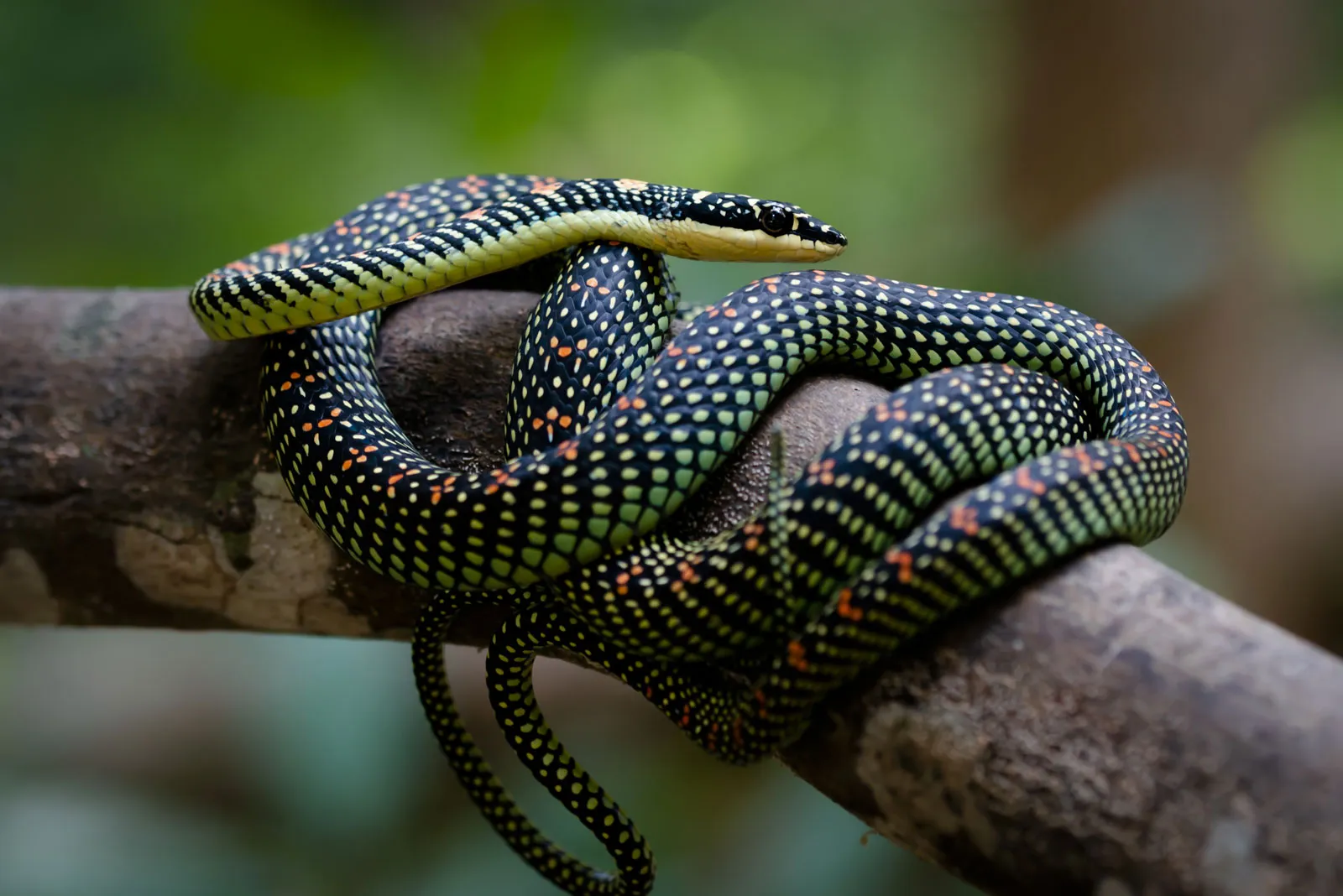In the lush, verdant realms of tropical rainforests, an extraordinary evolutionary marvel has perfected the art of arboreal living. The paradise tree snake (Chrysopelea paradisi) and its close relatives have developed a lifestyle so specialized that they can spend virtually their entire lives among the branches and leaves of forest canopies, rarely if ever descending to the forest floor. These remarkable reptiles represent one of nature’s most fascinating adaptations to a highly specialized ecological niche. Through a combination of unique physical characteristics, behavioral adaptations, and perhaps most impressively, the ability to glide through the air, these serpents have essentially freed themselves from the constraints of ground-dwelling that limit most other snake species. Their story is not merely about survival in the treetops but about the extraordinary evolutionary pathways that can emerge when species adapt to life in three-dimensional space.
The Flying Serpents: An Introduction to Chrysopelea
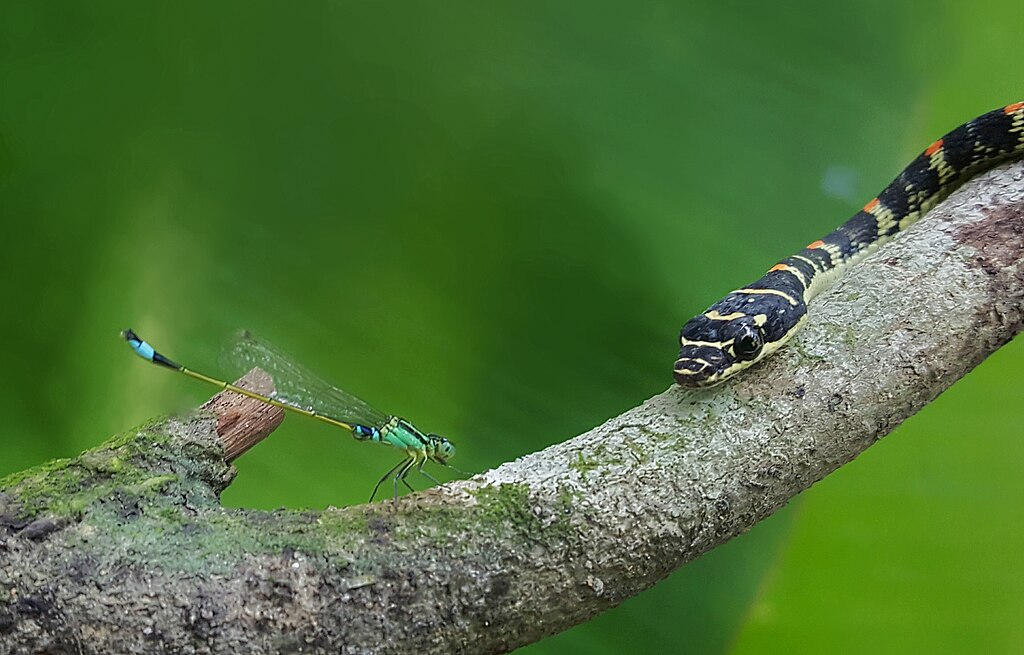
The genus Chrysopelea, commonly known as flying snakes or gliding snakes, comprises five recognized species that inhabit the tropical forests of South and Southeast Asia. Despite their fearsome moniker, these slender reptiles are completely harmless to humans, possessing only mild venom used to subdue their small prey. The paradise tree snake (Chrysopelea paradisi) stands out as perhaps the most accomplished aerial performer of the group, with its vibrant green coloration adorned with black cross-hatching and red or orange accents. These snakes typically grow to lengths between 3 and 4 feet, maintaining a remarkably slim profile that aids both in their arboreal lifestyle and their gliding capabilities. Their extraordinary adaptation to canopy living represents one of the most specialized ecological niches among reptiles, demonstrating evolution’s remarkable capacity to develop novel solutions for survival.
Evolution of Arboreal Adaptations
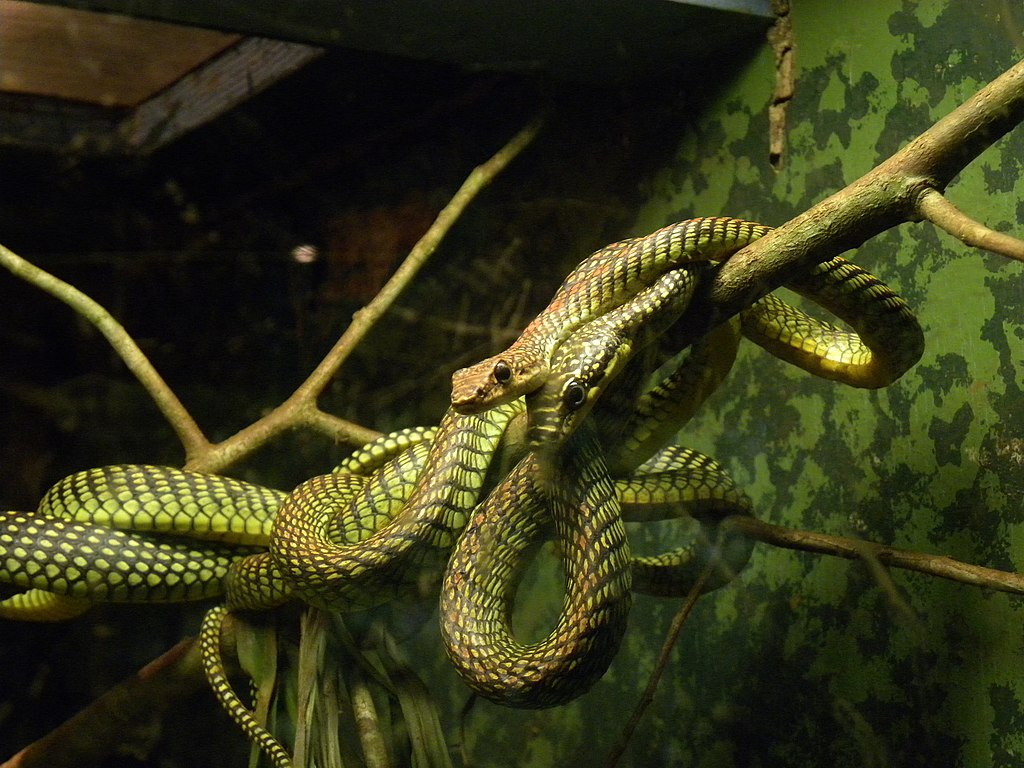
The evolutionary journey that led to Chrysopelea’s treetop lifestyle began millions of years ago when ancestral snakes found advantages in climbing vegetation to access new food sources and escape ground-dwelling predators. Over countless generations, natural selection favored individuals with physical traits that enhanced climbing ability, gradually leading to the specialized body form we see today. The most obvious adaptations include their exceptionally slender bodies, which reduce weight while maintaining strength, and specialized belly scales that create better purchase on branches and tree trunks. These ventral scales feature slight keels or ridges that can be manipulated by the snake’s muscular control to create friction against surfaces, allowing for secure movement even on near-vertical trunks. Additionally, the proportionally longer tail seen in flying snakes provides enhanced balance and control during both climbing and their remarkable aerial descents between trees.
The Physics of Snake Flight

The gliding ability of Chrysopelea species represents one of nature’s most unexpected adaptations and has fascinated scientists for decades. When preparing to launch, these remarkable reptiles dangle from a branch in a J-shape, carefully assessing their trajectory before propelling themselves into the air with a powerful push. Once airborne, they perform their most extraordinary feat—flattening their entire body by splaying their ribs outward, effectively transforming their cylindrical form into a concave wing-like structure. This dramatic shape change increases their surface area by up to twice the normal width, creating a crude but effective airfoil that generates lift. The snake further enhances this aerodynamic performance through undulating S-shaped movements, essentially “swimming” through the air to stabilize and control their descent. Research has shown these snakes can glide impressive distances—sometimes exceeding 100 feet—while maintaining remarkable control over their trajectory and landing position.
Specialized Anatomy for Tree Dwelling
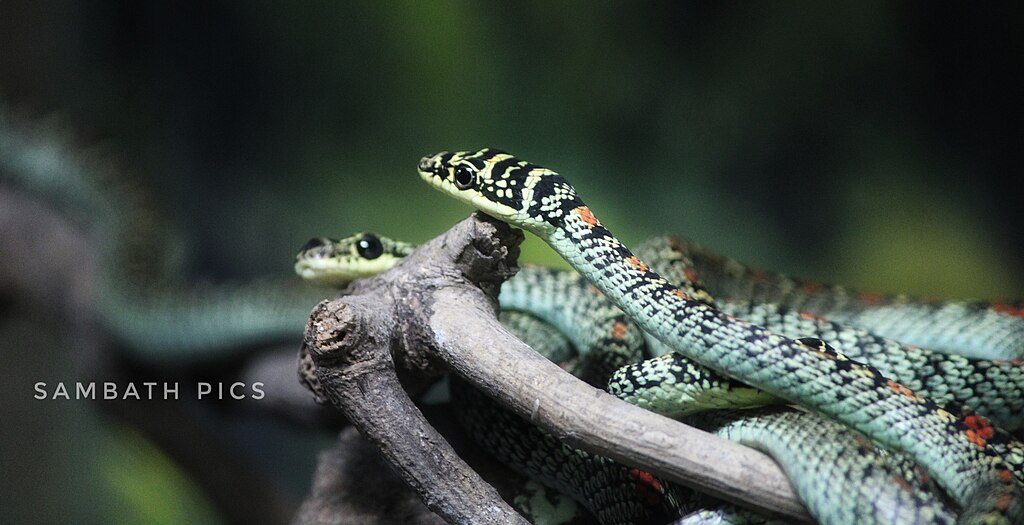
Beyond their gliding adaptations, flying snakes possess a suite of anatomical features specifically evolved for life in the canopy. Their eyes are proportionally larger than those of ground-dwelling relatives, providing excellent vision that allows them to judge distances accurately when planning jumps and identifying prey among complex foliage. The head is slightly flattened and streamlined, reducing air resistance during gliding while maintaining the snake’s ability to navigate through tight spaces in dense vegetation. Perhaps most crucial to their arboreal lifestyle is their remarkably lightweight skeletal structure—their bones retain strength while being less dense than those of ground-dwelling snakes, decreasing the energy required for climbing and supporting themselves on thin branches. Their specialized scales provide exceptional grip not only on tree trunks but also on leaves and slender twigs, allowing them to traverse even the outermost reaches of the canopy where potential prey might be found.
Hunting Strategies Among the Leaves
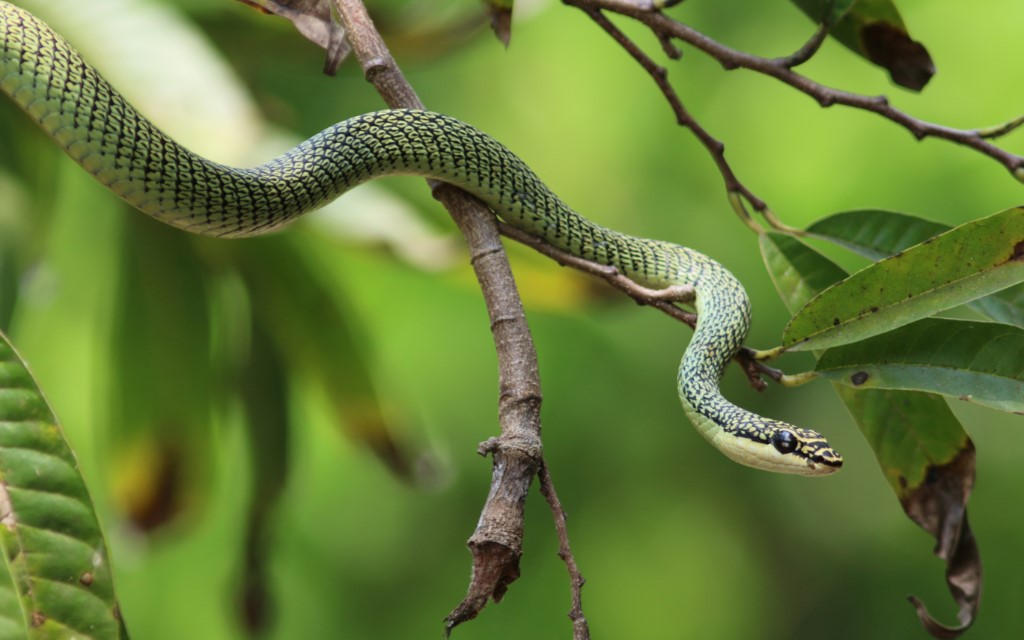
Life in the canopy presents unique challenges for predators, but flying snakes have developed specialized hunting techniques perfectly suited to their three-dimensional environment. These diurnal hunters rely primarily on their excellent vision to locate prey, which typically includes small lizards, birds, bats, and occasionally small rodents that share their arboreal habitat. When stalking potential meals, paradise tree snakes move with remarkable stealth, freezing into immobility when their prey becomes alert, then continuing their approach when the target’s attention wanders. Their hunting strategy often involves approaching from above or below rather than on the same branch, utilizing the full three-dimensional nature of their environment to remain undetected. Once within striking distance, they launch with impressive speed, securing their prey with sharp recurved teeth before quickly deploying their mild venom to subdue struggling victims, a necessary adaptation since falls from great heights would be dangerous for both predator and prey during extended struggles.
Navigating the Three-Dimensional Forest
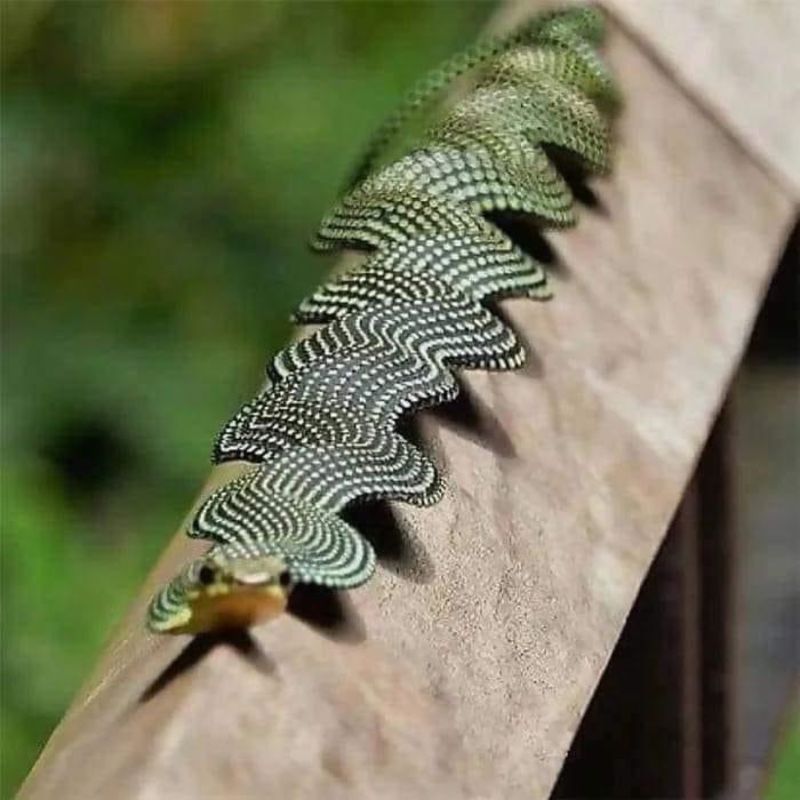
The ability to traverse a three-dimensional environment without descending to the ground requires exceptional spatial awareness and navigation skills. Flying snakes have developed remarkable cognitive abilities that allow them to construct mental maps of their territory, remembering the locations of productive hunting grounds, basking spots, and escape routes. Research suggests these snakes can recognize distinct features of their home range, including specific trees, gaps in the canopy, and even individual branches that have previously provided successful launching points for glides. This spatial memory proves crucial when they need to flee from predators, allowing them to quickly plan and execute escape routes that take advantage of their gliding abilities. Interestingly, these snakes appear to assess the risk-reward ratio of different gliding paths, sometimes choosing longer routes around gaps that would require particularly challenging glides, demonstrating a sophisticated understanding of their physical capabilities within their complex environment.
Reproduction in the Treetops
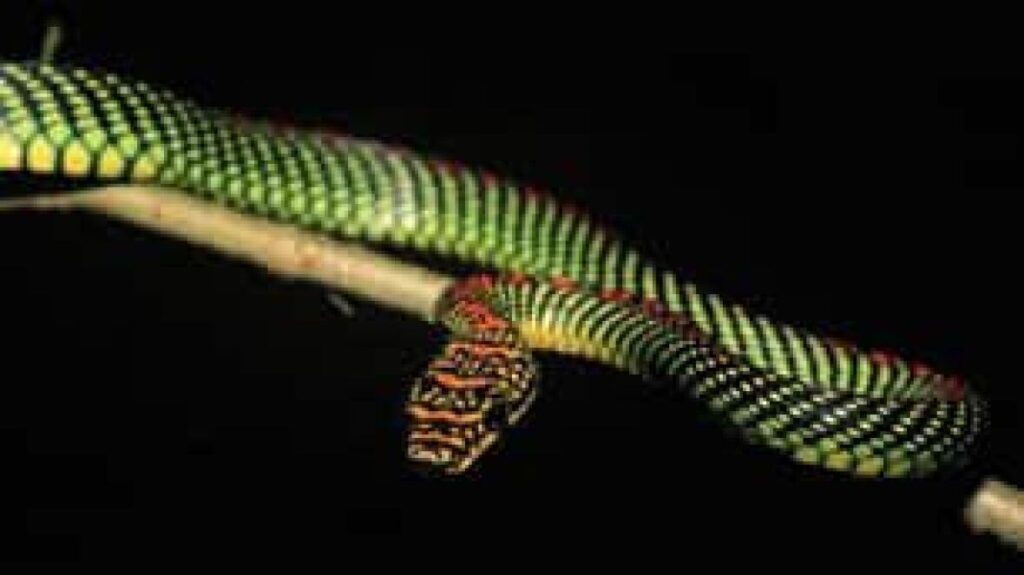
Even reproduction has been adapted to accommodate the flying snake’s commitment to canopy living, with mating behaviors and egg-laying strategies that minimize or eliminate the need to visit the forest floor. During breeding season, males track females through the canopy using both visual cues and chemosensory information detected by their forked tongues, sometimes traveling considerable distances between separated trees using their gliding ability. Unlike many snake species that lay eggs in soil or leaf litter, female flying snakes typically deposit their clutches of 6-12 eggs in tree hollows, abandoned bird nests, or accumulations of plant debris caught in branch forks high above the ground. This reproductive strategy protects eggs from many ground-dwelling predators, though it doesn’t eliminate threats from arboreal egg-eaters like certain birds and mammals. The young snakes hatch fully equipped with the instinctual knowledge and physical adaptations needed for canopy life, including the ability to glide, which they can perform successfully even on their first attempt without any period of learning or practice.
Predator Avoidance Without Ground Escape
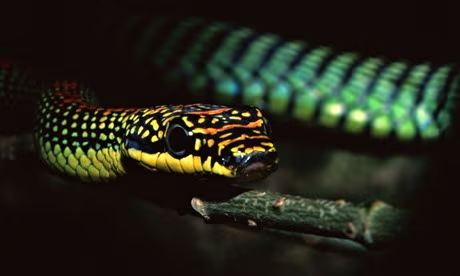
Despite their impressive adaptations, flying snakes are not apex predators and must contend with numerous threats from birds of prey, larger arboreal snakes, and some mammals that share their treetop domain. When faced with danger, their primary defense strategy leverages their unique gliding ability, allowing them to escape in three dimensions rather than being limited to the branch they occupy. When threatened, these snakes can launch into a glide with remarkable speed, often choosing directions that would be impossible for pursuing predators to follow. For closer encounters, they may employ defensive displays that include flattening their bodies, similar to their gliding posture, which makes them appear larger and more intimidating to potential threats. Their vibrant coloration, particularly in species with red or orange markings, may serve as an aposematic warning to predators, suggesting toxicity even though their venom poses little danger to larger animals. As a last resort, when cornered, they can strike defensively, though they typically prefer flight over fight when confronted with threats.
Ecological Role in Canopy Ecosystems
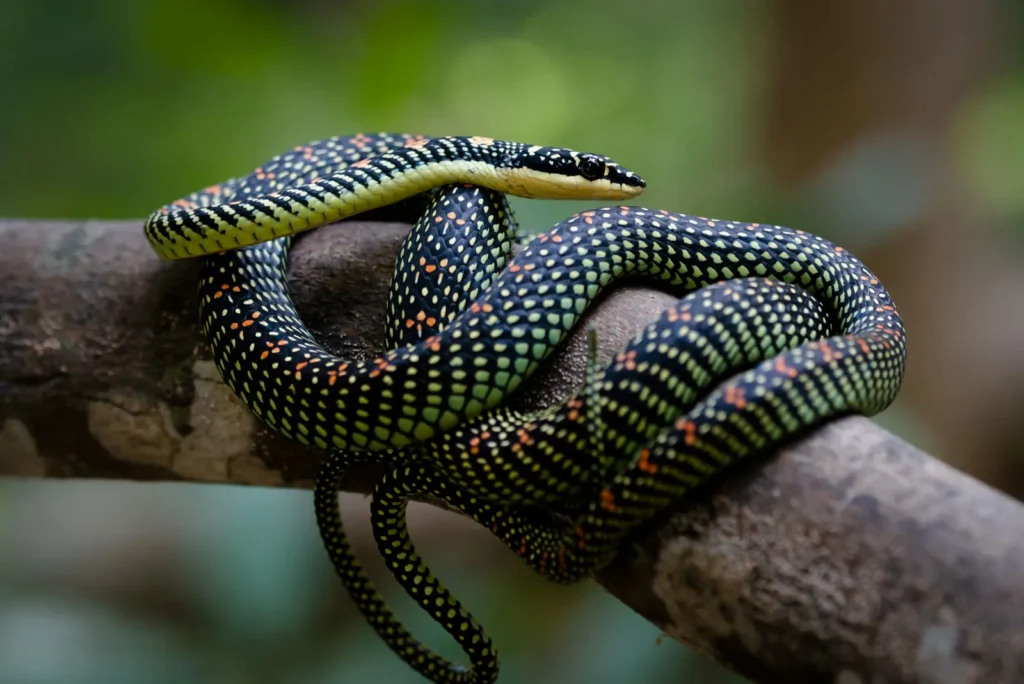
Flying snakes play a crucial role in the complex ecological web of tropical forest canopies, serving as both predators and prey in these biodiversity hotspots. As mid-level predators, they help control populations of small lizards and rodents that might otherwise damage vegetation through excessive consumption of fruits, seeds, and new growth. Their presence affects the behavior and distribution of their prey species, influencing how these smaller animals utilize the canopy space and contributing to the complex dynamics of species interactions at these heights. As prey themselves for larger predators, flying snakes represent an important energy transfer link in the food web, channeling the biomass of the smaller animals they consume up to apex predators like raptors and larger reptiles. Additionally, their hunting activities can indirectly benefit some plant species by controlling herbivorous prey populations, potentially contributing to the maintenance of plant diversity in these incredibly complex ecosystems.
Surviving Seasonal Challenges
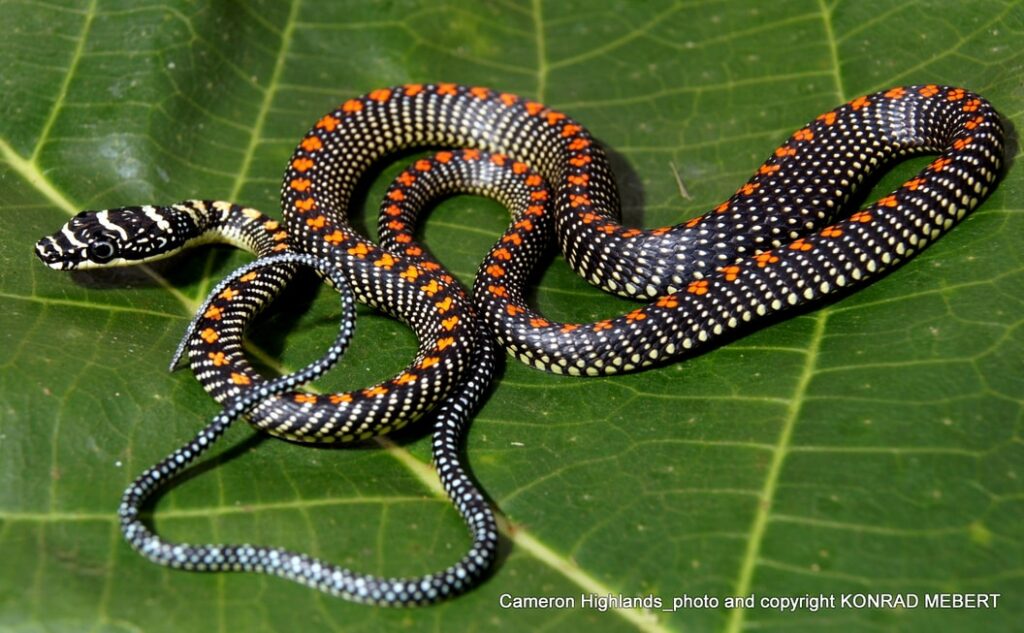
Even within the relatively stable environment of tropical rainforests, flying snakes must contend with seasonal variations that present unique challenges to their treetop lifestyle. During monsoon seasons, increased rainfall and powerful winds can make gliding more dangerous and less predictable, forcing the snakes to adapt their movement patterns and sometimes remain in more sheltered portions of the canopy. The heavy rains can also affect prey availability, with some potential food sources becoming less active or seeking shelter, requiring the snakes to modify their hunting strategies or focus on different prey species. In drier seasons, flying snakes face the challenge of maintaining hydration while rarely, if ever, descending to ground-level water sources. They have adapted by obtaining most of their moisture from their food and by drinking water that collects in tree hollows, leaf axils, and epiphytic plants like bromeliads that form natural reservoirs among the branches. This ability to find water in the canopy represents yet another adaptation that enables their remarkable independence from the forest floor.
Conservation Challenges for Arboreal Specialists
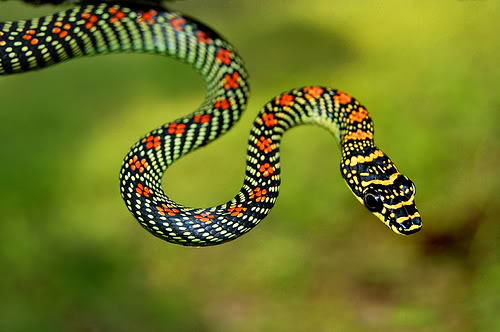
The highly specialized nature of flying snakes makes them particularly vulnerable to habitat disturbance, especially the large-scale deforestation occurring throughout much of their range in Southeast Asia. When forests are fragmented, the canopy becomes discontinuous, creating gaps that may exceed even the impressive gliding capabilities of these snakes and effectively isolating populations from one another. Climate change presents additional threats, as alterations in temperature and precipitation patterns can affect the delicate microclimate of the canopy, potentially disrupting the timing of breeding cycles or affecting prey availability. The specialized nature of flying snakes’ adaptations means they cannot easily adapt to alternative habitats such as plantations or secondary forests with simplified canopy structures that lack the complex three-dimensional environment they require. Conservation efforts focused specifically on maintaining connected canopy corridors between forest fragments could prove essential for preserving these remarkable reptiles and the unique ecological role they fulfill in tropical forest ecosystems.
Research Challenges and Scientific Discoveries
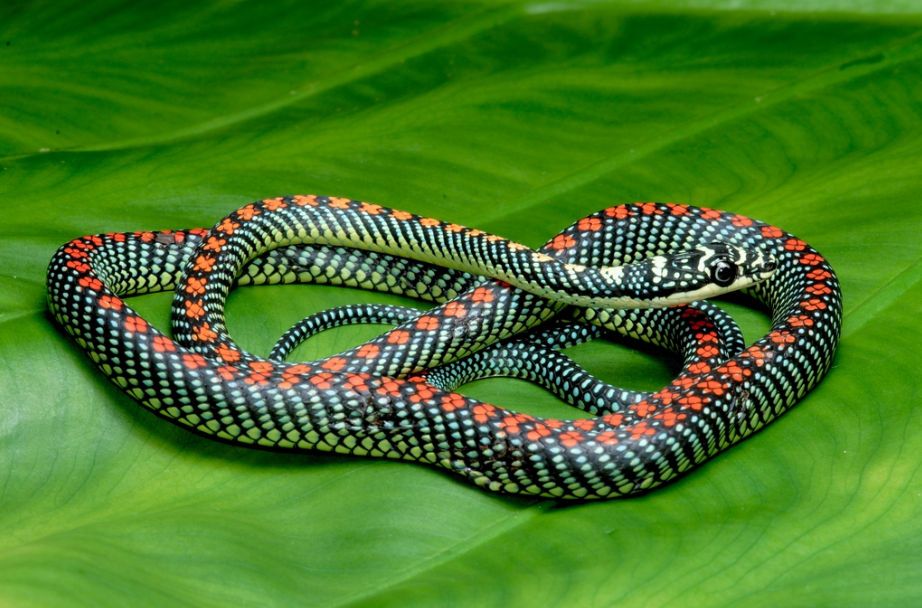
Studying creatures that spend their lives high in the forest canopy presents considerable challenges for scientists, which explains why many aspects of flying snake behavior remained poorly understood until recent decades. Innovations in research techniques, including canopy access methods like rope climbing systems and canopy walkways, have finally allowed researchers to observe these elusive reptiles in their natural environment. High-speed videography has been particularly revelatory, allowing scientists to deconstruct the complex biomechanics of gliding flight frame by frame, revealing the precise movements and body positions that generate aerodynamic lift. Wind tunnel testing with 3D-printed models based on CT scans of flying snakes has further advanced our understanding of the physical principles behind their aerial abilities. Despite these advances, significant knowledge gaps remain regarding many aspects of their natural history, including population densities, longevity in the wild, communication methods, and the full range of their cognitive abilities, making them an ongoing frontier in herpetological research.
Inspiration for Biomimetic Engineering
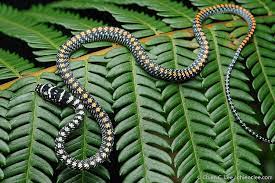
The remarkable gliding abilities of flying snakes have not only fascinated biologists but have also caught the attention of engineers interested in biomimetic design—the practice of drawing inspiration from nature to solve human engineering challenges. The unique mechanism by which these serpents transform their cylindrical bodies into effective airfoils has inspired designs for deployable structures that can change shape to serve different functions, potentially useful in applications ranging from aerospace to disaster relief. Some robotics researchers have attempted to recreate the undulating motion flying snakes use to stabilize their glides, developing snake-inspired robots that could potentially navigate complex three-dimensional environments inaccessible to conventional drones or ground vehicles. The energy efficiency of the snakes’ gliding technique, which requires only the initial muscular effort to launch and then uses gravity and aerodynamics for locomotion, offers valuable insights for developing low-energy transport systems and could contribute to more sustainable engineering solutions. As our understanding of these remarkable reptiles continues to grow, so too does their potential to inspire innovative technologies that mimic their unique adaptations.
The paradise tree snake and its relatives represent one of nature’s most specialized evolutionary pathways—creatures so perfectly adapted to canopy life that they’ve essentially transcended the limitations of their serpentine ancestors. Through remarkable adaptations, including their specialized scales, lightweight bodies, enhanced vision, and most dramatically, their ability to transform into living gliders, these snakes have created a life entirely among the leaves. In doing so, they’ve not only carved out a unique ecological niche but have also provided scientists with valuable insights into biomechanics, evolution, and the remarkable adaptability of life. As deforestation threatens their canopy kingdoms, preserving these aerial serpents becomes not just a matter of conservation but of protecting living examples of evolution’s extraordinary problem-solving capabilities. The flying snake stands as a testament to the boundless creativity of natural selection—a creature that, when faced with the challenge of life in the treetops, didn’t just adapt to climb better, but learned to fly.

